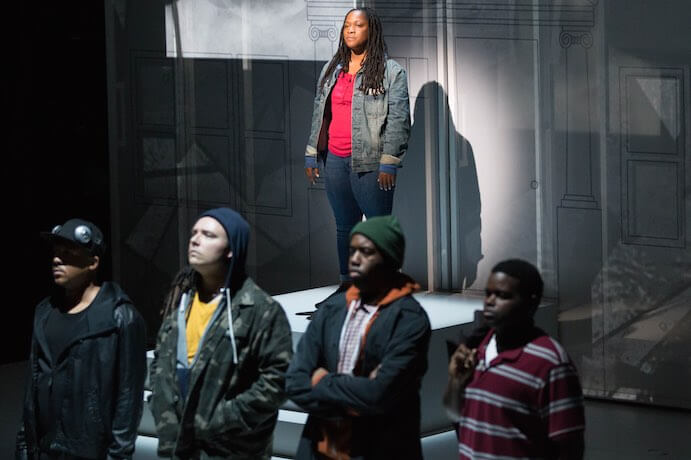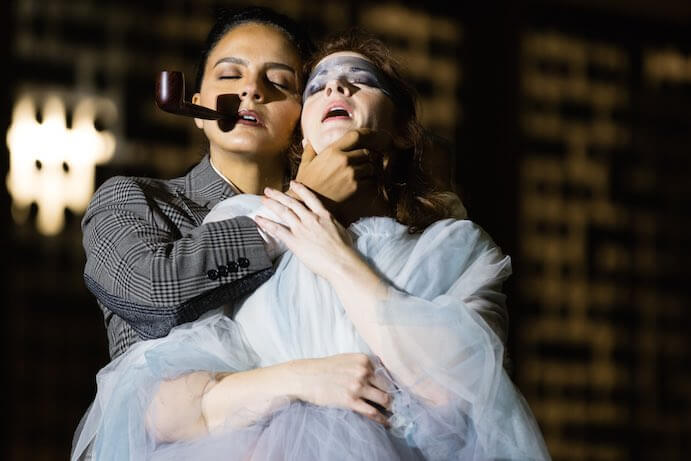In an unprecedented programming feat, Opera Philadelphia’s inaugural season opening festival, O17, staged 31 performances over 12 days in multiple venues across the city, including standard performance spaces such as the Perelman Theater, The Wilma Theater, and the Academy of Music alongside more unconventional venues like the Philadelphia Museum of Art, the Barnes Foundation, and the Independence National Historic Park.
On top of the inherent risk of merely putting on an event of this size, O17 doubled down and unabashedly continued in the innovative direction that Opera Philadelphia has been moving over the past several years. The decidedly contemporary focus of the festival featured world premieres of Kevin Puts and Mark Campbell’s Elizabeth Cree, Daniel Bernard Roumain and Marc Bamuthi Joseph’s We Shall Not Be Moved, and David Hertzberg’s The Wake World; the Philadelphia premiere of Lembit Beecher and Hannah Moscovitch’s I Have No Stories to Tell You; and director Barrie Kosky’s colorful reimagining of The Magic Flute.
While the theoretical concept of O17 was a major win for contemporary opera, one had to wonder—would people actually show up? Fortunately, sold out shows of enthusiastic crowds answered that question with a resounding YES, and both the subject matter of the operas and the novelty of certain venues and staging seemed to be significant draws. On September 23-24 during the closing weekend of the festival, performances of We Shall Not Be Moved and The Wake World succeeded in redefining “going to the opera” by challenging preconceived notions of operatic performance practice.
We Shall Not Be Moved challenges operatic conventions through the integration of disparate styles not often encountered in the concert hall. Using the 1985 police bombing of the MOVE organization’s West Philadelphia headquarters as a jumping off point, We Shall Not Be Moved considers contemporary systemic racism and police brutality through the lens of five North Philly black-identifying teens—Un/Sung, John Henry, John Blue, John Little, and John Mack—who have bonded together to form a family.

Un/Sung (spoken word artist Lauren Whitehead) and her brothers (L-R) John Henry (bass-baritone Aubrey Allicock), John Little (tenor Daniel Shirley), John Mack (baritone Adam Richardson), and John Blue (countertenor John Holiday) make up the Family Stand–Photo by Dominic M. Mercier.
The core of We Shall Not Be Moved examines the repercussions of school closures that leave children without access to education and exposed to violence. After the teens’ school is closed, John Blue is involved in a fatal shooting, and the family takes up residence in the remains of the MOVE organization’s headquarters to consult the ghosts of their predecessors (played by a troupe of dancers). Tensions quickly intensify as Glenda, a police officer, finds the teens, gets startled in a confrontation, and mistakenly fires her weapon at John Henry.
Along with relevant contemporary themes, what makes We Shall Not Be Moved so effective as an opera is the seamless integration of styles in the instrumental music, methods of text delivery, and dancing. Roumain’s score makes use of short, repetitive motives, memorable hooks, and syncopated but perceptible grooves that reference contemporary classical music, hip-hip, funk, R&B, gospel, and soul, which engages the audience through an inventive confluence of familiar sounds. The delivery of the libretto ranges from Un/Sung’s brutally emotional spoken word–performed in an engaging, impassioned flow by Lauren Whitehead–to transgender John Blue’s soaring lyricism–virtuosically sung by the outstanding countertenor John Holiday. Bill T. Jones’ choreography blends hip-hop, breaking, modern classical, and African dance. While this all-out fusion of modern styles makes We Shall Not Be Moved relatable for contemporary audiences, the work is still firmly grounded in operatic conventions: arias that contemplate a single emotion or subject using repeated melodies; quintets that bring divergent narratives together; and choruses that proclaim powerful messages.
While the music, text delivery, and choreography of We Shall Not Be Moved challenged ideas of operatic content, Hertzberg’s The Wake World stretched the concept of operatic staging and venue. Tasked with creating a site-specific opera for the Barnes Foundation, Hertzberg found inspiration in Dr. Albert Barnes’ approach to curating his massive collection of Modernist and Post-Impressionist art. In his visits to the museum, Hertzberg sensed a shared “aesthetic maximalism” between Barnes and another early 20th century visionary: the eclectic English occultist Aleister Crowley, author of the absurdist fairytale The Wake World.
Hertzberg’s The Wake World retains the basic framework of Crowley’s fairytale: a girl’s ambiguous psychological journey from innocence to awakening. At the behest of her fairy prince—here, a woman, sung by the sultry mezzo soprano Rihab Chaieb—Lola, sung by the powerfully shimmering soprano Maeve Höglund, is guided on a journey through a mystical palace that is both grandiose and terrifying. Hertzberg’s lush score reflects the aesthetic of much of the art found in the gallery—Debussy-like chordal planes that accompany sweeping chromatic lines and muted brass interjections—yet also achieves a Straussian lyrical intensity at the work’s climactic peaks. The result is a sort of high intensity Impressionism, which reaches its height at the transfigured-through-love finale. As one audience member put it, “There was a lot of ecstasy.”

The Fairy Prince (mezzo-soprano Rihab Chaieb) guides Lola (soprano Maeve Höglund) through his palace.
Patrons were granted admission to the gallery one hour prior to the show in order to immerse themselves in the collection before gathering around a long catwalk in the main atrium. R.B. Schlather’s staging of The Wake World creates a fluid experience, encouraging audiences to move around the space and observe the cast up close. This intimacy and physical closeness slashed through the idea of opera as a grand spectacle to be viewed from afar, and many patrons took full advantage of this interactive offering.
Though the staging and the site-specific nature of the work were perhaps its largest draws, one does have to wonder how a more traditionally staged version of The Wake World, complete with sets, would fair. While Schlather’s staging in the Barnes Foundation provided an experience like no other, the emotional intensity of the score coupled with a dense libretto grew increasingly taxing to process without a visual component to complement the other-worldly beauty and nightmarish encounters described in the poetry. Regardless, Schlather’s staging created a sensational spectacle that left a memorable impression with audiences.
It was a tremendous risk—but O17 appears to have paid off handsomely. The festival was an absolute triumph thanks to smart programming, excellent execution, and successful marketing. And the best part? People packed performance venues throughout Philadelphia in the name of contemporary opera.




















